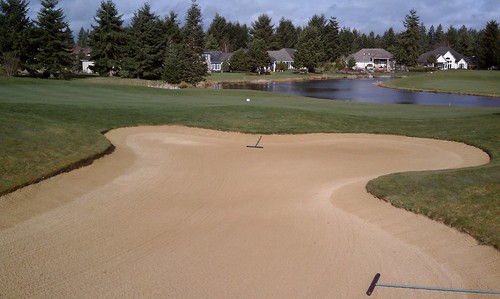
The weather has not given us much remorse this past week. Rain has been a loyal companion as we forge ahead into the start of the season. The Men's opening dinner went well with great comments and a warm welcoming. I mentioned a couple things that we would be working on over the next couple weeks to prepare the course for spring.

Trimming the underbrush and limbing up some low hanging branches is an ongoing process. These areas that we can clean up help us in a few different ways. The obvious is being able to better find and play your ball. The not so obvious that we benefit from is allowing sprinklers to operate without obstruction, mowers to be able to travel without interuption and better air movement and sunlight to increase the health of the turf. We like projects that increase playabilty and help us out at the same time.
Bunkers work has also become a priority coming into the season. We have some bunker sand stock piled out near #5. We use this sand to top off bunkers with subsoil showing, or sand that is too shallow. The bunkers that have sand added to them will be a little more fluffy than the others until the sand settles.
Along with these small projects, we are keeping a constant eye on the greens to make sure nothing out of the ordinary pops up. Dan found some Pink Snow Mold (Microdochium Patch) on #8 green. As I stated on the turf page of our members website, I look at problems and try to understand them fully to hopefully be able to come up with a sound solution. Since we sprayed a fungicide 21 days ago and it should have lasted 28 days, I asked the question, "Why?"

When we spray greens we split the course into two tanks, since one tank is not enough volume to cover all the greens. 8 green just happens to be the last green on a tank. My inner turf nerd tells me that we need to investigate how our spray rig works toward the end of a tank. Did we get good coverage?

If you have any questions about turf disease, bunkers or thinning and trimming, please feel free to send me a message or contact my office.
Justin Ruiz, CGCS
justinr@indiansummergolf.com
360.459.2707
 The last aerification cycle we harvested some of the plugs to replace some of our small putting green. If you have been around the practice area lately you probably have noticed this area. We currently have it roped off and it will not be usable until spring.
The last aerification cycle we harvested some of the plugs to replace some of our small putting green. If you have been around the practice area lately you probably have noticed this area. We currently have it roped off and it will not be usable until spring.






















































